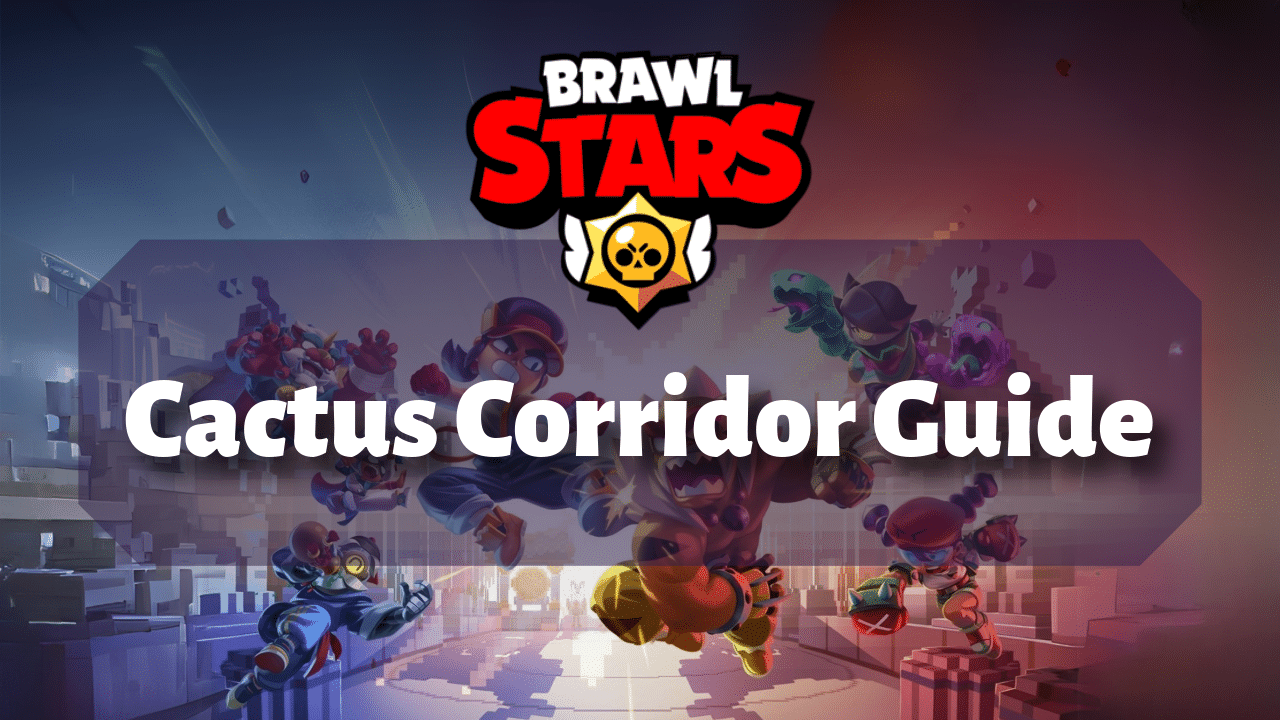
- Slugfest 01
- Slugfest 02
- Slugfest 03
- Sandstone Block – 18
- Wooden Box – 14
- Wooden Barrel – 12
- Wooden Fence – 14
- Cactus – 10
- Bush – 116
- Lake – 3
Brawl Stars Cactus Corridor Guide: Introduction
The Brawl Stars Cactus Corridor is a tactically demanding battleground, blending open spaces with narrow pathways. Its desert theme offers strategic challenges, featuring walls, bushes, and barricades that provide cover and create opportunities for ambushes or flanking. These obstacles require players to position themselves carefully and react quickly to changing situations. The central open areas encourage combat, while the narrow corridors add complexity, making it essential to stay aware of both positioning and enemy movements.
The layout of the Brawl Stars Cactus Corridor lends itself to fast-paced action where holding the central position can often provide a strategic advantage. Players need to focus on balancing their offensive pushes with defensive positioning, ensuring that they don’t overextend and leave themselves vulnerable to enemy flanking maneuvers. The layout also places a strong emphasis on team coordination, as success on this map often hinges on how well players can communicate and support one another. Whether trying to secure gems in Gem Grab or eliminate the opposing team in Bounty, understanding the flow of the map and the optimal placement of your brawlers is essential for outmaneuvering your opponents.
The Brawl Stars Cactus Corridor map’s mix of open space and tight pathways makes certain brawlers more effective. Brawlers with high mobility, area control, or burst damage thrive here. Mobile brawlers like Leon or Crow can quickly navigate narrow lanes to flank enemies, while ranged brawlers such as Piper or Brock can control outer lanes and pressure the center from a distance. Tanky brawlers like Bull and El Primo excel at securing the central position and pushing through chokepoints.
To truly excel on the Brawl Stars Cactus Corridor map, players must adopt a flexible and adaptable approach. It’s not just about brute force but also about outthinking your opponents and capitalizing on their mistakes. Whether holding a defensive position, planning an ambush, or initiating a coordinated push, understanding how to manipulate the terrain and obstacles will give you the edge in battles. This guide will provide a detailed breakdown of the Cactus Corridor map’s features, offer brawler recommendations, and highlight effective strategies to help you navigate the map with ease and efficiency, ultimately increasing your chances of success and securing victory.
Brawl Stars Cactus Corridor Guide: Map Layout
The Brawl Stars Cactus Corridor map features a mix of narrow paths and open spaces, providing a balanced environment for both long-range and close-quarters combat. Dominating the map is a central area surrounded by several obstacles like walls and cacti, which can be used for cover or ambush tactics. This central zone is exposed and becomes the key battleground, often determining the flow of the match. Surrounding the central space are narrow corridors with limited visibility, forcing teams to plan their movements carefully to avoid surprise attacks.
While there are no major environmental hazards like spikes or fire zones, the uneven distribution of obstacles requires players to be aware of their surroundings and use the terrain to their advantage. This map encourages quick decision-making and reactive play, often putting players into close-range engagements or requiring them to outmaneuver opponents using available cover. The layout is designed to challenge players’ adaptability and ability to make quick strategic decisions.
Control of the central area in Brawl Stars Cactus Corridor is crucial for gaining an advantage. The central zone provides access to key areas and becomes the focal point for battles, especially in modes like Gem Grab or Heist. The open nature of this area makes it vulnerable to attacks from opponents hiding behind obstacles, which means teams must maintain excellent positioning and awareness to secure it. Holding the center allows a team to apply pressure on the enemy, dictate the match’s pace, and secure objectives.
However, the central area’s exposed nature makes it easy for opponents to take advantage of teams that overcommit. If a team rushes into the center without adequate support from the outer lanes, they risk being caught off guard, losing control of the Brawl Stars Cactus Corridor map. Therefore, controlling the center requires a balance of offensive pressure and defensive positioning, as teams must avoid leaving themselves vulnerable to flanks or surprise attacks.
Brawl Stars Cactus Corridor Guide: Recommended Brawlers
Choosing the right brawlers for Brawl Stars Cactus Corridor is essential for dominating the map and achieving victory. Due to the map’s combination of narrow corridors and open spaces, brawlers who excel in close-range combat, mobility, and area control tend to thrive. Tank brawlers, ranged attackers, and mobile brawlers all have specific advantages in this environment, and knowing when to select each type can significantly influence the outcome of the match.
Tank Brawlers
Tank brawlers like Bull and El Primo are perfect for controlling the central area in Brawl Stars Cactus Corridor. With their high health and strong close-range damage, they excel at pushing forward, soaking up damage, and creating space for teammates. These brawlers can dominate the open areas, applying pressure on enemies and securing objectives. Bull’s charging ability helps break through enemy defenses, while El Primo’s jump allows him to directly engage opponents in the center. Their durability and ability to disrupt enemy formations are crucial for holding the central zone. However, they should be supported by teammates who control the outer lanes and protect their flanks.
Ranged Brawlers
Ranged brawlers like Piper, Colt, and Brock excel on Brawl Stars Cactus Corridor due to their long-range abilities. Positioned in the outer lanes, they can stay behind cover and deal damage from a safe distance. Piper’s burst damage, Brock’s area rockets, and Colt’s rapid-fire shots help pressure enemies and prevent them from advancing toward the center. These brawlers are crucial for controlling the outer regions and supporting tanks in securing objectives, allowing teams to control key areas while minimizing close-range risk.
Mobile Brawlers
Brawlers with high mobility, like Crow and Leon, are highly effective in Brawl Stars Cactus Corridor’s narrow lanes. Their speed lets them navigate the map quickly and exploit gaps in the enemy’s defense. Leon, with his stealth ability, can sneak past enemies to eliminate key targets and disrupt their strategies. Crow’s poison attacks chip away at enemy health while slowing them down, making it easier to isolate targets. These mobile brawlers excel at flanking and surprise attacks, using narrow corridors to slip past the enemy and create openings for their team.
Selecting the right brawlers for Brawl Stars Cactus Corridor requires an understanding of the map’s layout and the role each brawler plays in contributing to a team’s success. Tank brawlers are essential for controlling the central area, ranged brawlers provide consistent pressure and support, and mobile brawlers excel at flanking and creating distractions. By combining these brawler types effectively and coordinating with teammates, players can take advantage of Cactus Corridor’s layout and ensure they control both the central zone and outer lanes, leading to a strategic advantage.
Brawl Stars Cactus Corridor Guide: Heist Event in Cactus Corridor
The Heist event on the Brawl Stars Cactus Corridor map is an exciting, fast-paced experience that requires teams to carefully balance aggression and defense. The central area of the map, where the safe is typically located, becomes the focal point for both attackers and defenders. Attackers need to push into this exposed central zone, dealing damage to the safe while avoiding defenders’ counterattacks. Defenders, on the other hand, must use the narrow paths and obstacles around the center to create chokepoints, slowing down the attacking team and preventing them from reaching the safe.
Flanking plays a vital role in Heist on Brawl Stars Cactus Corridor. The narrow lanes and various obstacles allow brawlers to sneak around the central zone and surprise opponents. Attackers can use these paths to get behind the enemy and deal damage to the safe from unexpected angles. Brawlers with mobility, such as Leon or Crow, are especially effective in flanking, as they can quickly maneuver around the map and catch defenders off-guard. Meanwhile, defenders must stay vigilant, ensuring that their flanks are covered and preventing attackers from taking advantage of any openings.
Brawlers that perform well in Brawl Stars Cactus Corridor’s Heist mode are typically those with high mobility or strong burst damage. Tank brawlers like Bull and El Primo are excellent choices for attackers, as their ability to deal substantial close-range damage allows them to push toward the safe and disrupt enemy defenses. For defense, ranged brawlers like Brock or Piper are useful, as they can deal damage from a distance, pressuring attackers while staying behind cover. Brawlers like Jessie or Barley, who can control areas with splash damage, are also valuable for preventing attackers from advancing.
Team coordination and communication are critical for success in Heist on the Brawl Stars Cactus Corridor map. Attackers need to time their pushes carefully and coordinate with teammates to ensure they can consistently apply pressure on the safe. Defenders must work together to cover multiple angles and stop attackers from gaining access to the safe. Clear communication helps teams adapt to changing situations, whether it’s executing a push or organizing a defense. A well-coordinated team can take full advantage of the Cactus Corridor’s layout, turning the map’s challenges into opportunities for victory.
Brawl Stars Cactus Corridor Guide: Tactical Strategies
The Brawl Stars Cactus Corridor map is a challenging and dynamic battlefield, requiring a combination of strategy, quick thinking, and solid team coordination. With its unique mix of open areas and narrow pathways, players must carefully balance aggression and defense to gain control. The map’s layout encourages close-quarters combat while also providing opportunities for ranged brawlers to exert pressure. This guide will explore the best strategies to navigate the Cactus Corridor, highlighting key tactics and tips to help teams succeed.
⭐ Control the Central Area
The central area of the Brawl Stars Cactus Corridor is the heart of most engagements and offers key advantages in terms of access to objectives. Teams that control this space can dominate the flow of the match, whether in Gem Grab, Heist, or any other mode. However, the central area is also exposed and vulnerable to attacks from all directions. To effectively control it, teams should maintain good positioning, use cover to their advantage, and support each other by keeping an eye on both the central zone and the narrow lanes. It’s essential to avoid overextending without backup, as this can lead to getting caught off guard by enemies using the map’s obstacles for cover.
⭐ Flanking Tactics
Flanking plays a critical role in Brawl Stars Cactus Corridor, thanks to its narrow corridors and strategic cover. Brawlers with high mobility, like Leon or Crow, can use these narrow lanes to sneak behind enemy lines and attack from unexpected angles. Flanking forces the enemy to spread out and react quickly, often catching them off-guard and disrupting their strategy. Successful flanks require good timing and teamwork, so communication is key. When your team executes a flanking maneuver, make sure to coordinate it with your control of the central area to ensure that enemies don’t escape or regroup in another section of the map.
⭐ Push or Retreat
The fast-paced nature of the Brawl Stars Cactus Corridor map means knowing when to push and when to retreat is crucial. Overcommitting to a push, especially in the open center, can lead to disastrous results if the enemy has the upper hand or is in better positions. Conversely, retreating strategically can allow your team to reset and regroup for another attempt with better coordination. A well-timed retreat also gives your team a chance to reposition in a more advantageous area or defend against a counterattack. Recognizing when to hold your ground and when to fall back is key to maintaining map control and keeping your team in the game.
⭐ Use of Obstacles for Cover and Surprise
The Brawl Stars Cactus Corridor is filled with a variety of obstacles like walls, cacti, and bushes, which can be used strategically for cover or to set up surprise attacks. Teams should make use of these elements to block line of sight, avoid damage, and force enemies into unfavorable positions. Tank brawlers can use these obstacles to protect themselves while pushing into the center, while ranged brawlers can take advantage of cover to fire from a distance without being hit. Additionally, stealth brawlers like Leon can use bushes and other cover spots to hide and prepare surprise attacks on unsuspecting opponents. Mastering the use of terrain and obstacles is key to gaining an advantage in engagements.
To master the Brawl Stars Cactus Corridor map, teams need to blend offense with defense by securing the central area, executing successful flanks, and knowing when to push or retreat. By staying aware of the map’s features, communicating effectively, and working together to control key positions, teams can significantly improve their chances of success. Whether you’re playing aggressively or strategically, adapting to the map’s flow and responding to enemy movements will provide you with a decisive advantage and increase your likelihood of securing victory.
Brawl Stars Cactus Corridor Guide: Conclusion
The Brawl Stars Cactus Corridor map is a challenging yet rewarding environment that requires players to demonstrate tactical gameplay, precise positioning, and effective coordination. The map’s unique layout, combining both open areas and narrow corridors, makes it essential to understand how to manage different spaces and engage opponents strategically. Success on this map hinges on controlling the central area, which serves as the focal point for much of the action, while also being aware of the narrow pathways where enemies can sneak up or flank from unexpected angles.
To succeed in the Brawl Stars Cactus Corridor, players need to carefully select brawlers that complement their strategy and the layout of the map. Tank brawlers like Bull and El Primo are invaluable for holding the central area, while ranged brawlers such as Piper and Brock can support their team by pressuring the enemy from a distance. Mobility-focused brawlers, like Leon and Crow, are great for flanking and creating chaos in enemy ranks. The right combination of brawlers can help teams dominate specific sections of the map and create opportunities for coordinated pushes.
Flanking strategies are a crucial aspect of success in Brawl Stars Cactus Corridor, especially given the narrow lanes and various obstacles that provide cover. Brawlers with mobility should be used to quickly navigate the tight corridors and catch opponents off-guard. By coordinating flanks with teammates controlling the center, players can force the enemy to retreat or scatter, giving their team the upper hand. Timing these maneuvers, combined with strategic pushes and careful retreats, is essential for maintaining map control and pressuring the opposing team.
Mastering the flow of the Brawl Stars Cactus Corridor requires not only quick thinking and adaptability but also a deep understanding of how to use the map’s unique features to your advantage. Whether it’s using obstacles for cover, setting up surprise attacks, or reading the enemy’s movements, the key to excelling lies in staying alert and responsive. While it may take time to perfect strategies and execution, with practice and teamwork, players can excel in the Cactus Corridor, making it a dynamic and exciting battleground to conquer. By prioritizing coordination, smart positioning, and adapting to the fast-paced nature of the map, teams can consistently achieve success and secure victory.













